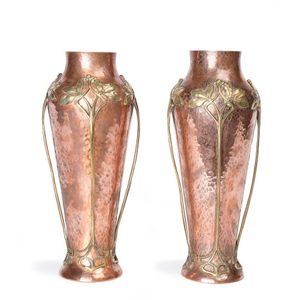Doulton Lambeth Faience Vases with Marine Creatures & Putti
You must be a subscriber, and be logged in to view price and dealer details.
Subscribe Now to view actual auction price for this item
When you subscribe, you have the option of setting the currency in which to display prices to $Au, $US, $NZ or Stg.
- Circa - A Latin term meaning 'about', often used in the antique trade to give an approximate date for the piece, usually considered to be five years on either side of the circa year. Thus, circa 1900 means the piece was made about 1900, probably between 1895 and 1905. The expression is sometimes abbreviated to c.1900.
- A/f, as Inspected - The letters "A/F" or "as inspected" as part of a description is the cataloguer's shorthand for "all faults" or "as found", meaning the item has some type of damage or deficiency, it is of uncertain date or provenance, and/or that the seller takes no responsibility for the completeness of the item or the accuracy of the description.
- Putto / Putti / Amorino / Amorini - A putto (plural: putti) or amerino (plural: amerini) is a cherub or cupid frequently appearing in both mythological and religious paintings and sculpture, especially of the Renaissance and Baroque periods and later used as a decorative element in the design of furniture, ceramics, statuary etc. They are usually depicted as chubby males, or of indeterminate gender, often with wings. Their depiction may represent an association with love, heaven, peace or prosperity.
- Faience / Maolica - Originating in ancient Egypt, faience is the name given to tin-enamelled porcelain or earthenware, deriving its name from Faenza in Northern Italy. Also known as maiolica because at one time the wares passed through Majorca. In England, faience / maoilca underwent a revival in the late 19th century by the art potteries set up about that time.
Majolica was the name given to a specific product evolved by Minton in 1851 and introduced at the Great Exhibition. The pottery was coloured with a clear glaze containing metallic oxides.
This item has been included into following indexes:
-
Royal Doulton (England), item types
- Lambeth Ware, vases 258
- ovoid and baluster shaped vases 1,515
- vases, other 743
- Smallfield, Katherine - Royal Doulton, designers 2
Visually similar items

A pair of copper and brass Art Nouveau vases by WMF signed, Austrian, circa 1905. 38.5 cm high, 15 cm wide

A pair of Royal Doulton glazed stoneware ewers, by Eliza Simmance, c1880 for the Art Union of London, decorated with pink flowers on a green, blue and brown ground, inscribed initials, assistant initials for Florrie Jones and Harriette Knight, no 939, impr

A George III sterling silver, bright cut cream jug, Duncan Urqhart and Naphtali Hart, London 1797 initialled D within cartouche, 99 grms

A Doulton Burslem 'Blue Iris' patterned vase, re-gilded at the rim. Height 10.5 cm
